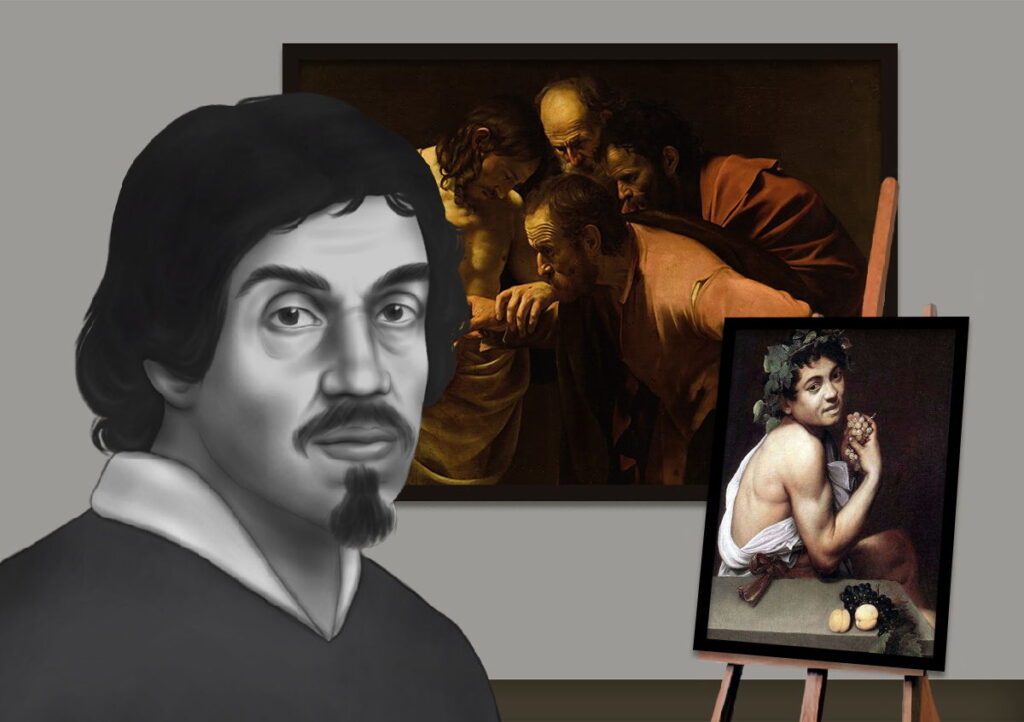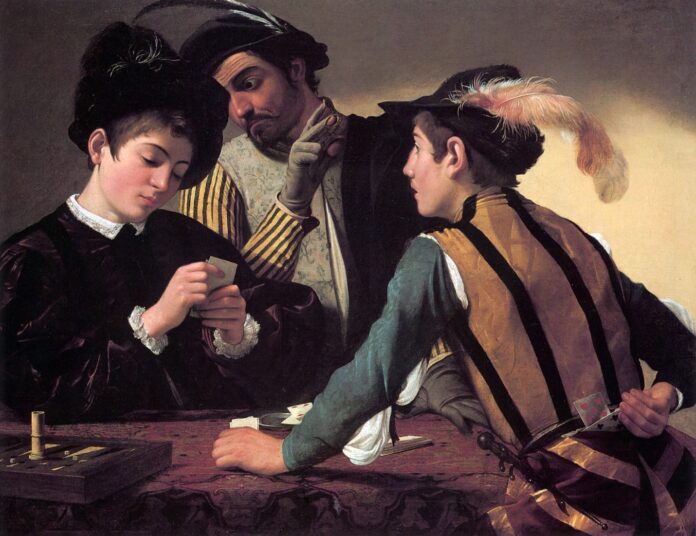Immersing ourselves in the world of Caravaggio’s “The Cardsharps,” we’re immediately struck by its intricate tableau of guile and innocence. This masterpiece cleverly unfolds an extraordinary narrative centered around the timeless vice of gambling, a pervasive theme prevalent even in our contemporary society. The article before you embark on a journey to delve into the profound depth of this remarkable artwork. Each stroke and hue woven into the canvas encapsulates the artist’s genius, offering glimpses into a narrative of unique composition, brimming with compelling symbolism. What truly sets this masterpiece apart is Caravaggio’s distinctive employment of light and shadow, a testament to his mastery of the technique known as ‘chiaroscuro.’ The resultant interplay of light and dark masterfully brings the characters to life, dramatically heightening the tension within the scene. The amalgamation of these artistic elements serves not only to dazzle our visual senses but also to stir our emotions, as the painting poignantly evokes themes of deceit, vulnerability, and the potential fallout of our actions.
“The Cardsharps,” completed circa 1594, serves as a testament to the artistic prowess of Caravaggio—born Michelangelo Merisi—whose penchant for dramatic realism and chiaroscuro helped define the Baroque period. The painting, currently housed in the Kimbell Art Museum in Fort Worth, Texas, presents a tense scene of two card players—one naive, the other deceitful—and a cunning accomplice.
Caravaggio’s artistic approach, often referred to as Caravaggisti, uses chiaroscuro, a method of contrasting light and dark, to give depth and three-dimensionality to his figures. In “The Cardsharps,” the application of this technique augments the intensity of the narrative, illuminating the young player while enveloping the duplicitous characters in a nebulous shroud of shadows. As we unravel the layers of Caravaggio’s masterpiece, we’re led into a world of strategic deception, reminiscent of the intricate strategies and calculated moves observed in “The Cardsharps”. Much like the suspenseful gamble experienced within the painting, we can draw parallels to the unpredictable nature of games, reflecting the thrill and potential rewards offered by New York Online Casinos. However, while the calculated risks are part of the allure, both scenarios serve as a reminder of the importance of reading the game and understanding the potential consequences.
The ingenuity of Caravaggio’s composition extends beyond his technical skills, as he skillfully weaves societal realities of the 16th century into his narrative. Through an unromantic portrayal of the characters, Caravaggio paints a vivid picture of the harsh realities of the era, thereby distinguishing his work from the idealized and embellished art of the Mannerist period.
The life of the artist was as tumultuous and fascinating as his works. Known for his violent temper and legal troubles, Caravaggio’s life was filled with frequent relocations across Italy, which only served to enrich the depth of his art. His personal experiences, often on the brink of lawlessness, are mirrored in his works, including “The Cardsharps,” where the line between right and wrong is blurred. Analyzing the painting further, it becomes evident that Caravaggio employed ‘genre painting’ to stage his narrative, focusing on scenes from everyday life. He emphasized realism, making each character and object within “The Cardsharps” feel tangible and grounded in reality.
Upon its unveiling, “The Cardsharps” was met with acclaim for its lifelike representation, intricate detail, and psychological insight. The painting, through its gripping narrative and visual dynamism, solidified Caravaggio’s reputation, cementing him as one of the most influential figures of his time.

Delving into Caravaggio’s Biography:
The tumultuous and eventful life of Caravaggio is often seen mirrored in his dramatic art. His rebellious nature and run-ins with the law have been well documented, yet it’s these experiences that provided the raw material for his artwork, helping his paintings resonate on a deeply human level.
Walking through the streets of Rome, where Caravaggio spent his formative years, one can’t help but notice the disparity between the classes, a reality often reflected in his works. For instance, in “The Cardsharps,” the stark contrast between the young player’s lavish attire and the older cardsharp’s simple dress serves as a commentary on the socio-economic divide of the era.
The allure of “The Cardsharps” lies in Caravaggio’s unique ability to captivate viewers with vividly real portrayals and deeply emotive themes. His use of chiaroscuro and dramatic storytelling would influence a generation of artists, securing his legacy as one of the true masters of the Baroque period. As we step back from the canvas, we can appreciate more than just the artistic prowess of Caravaggio. “The Cardsharps,” with its compelling narrative and poignant themes, offers a rare insight into the complexities of human nature— a spectacle as relevant today as it was during the late 16th century.

























